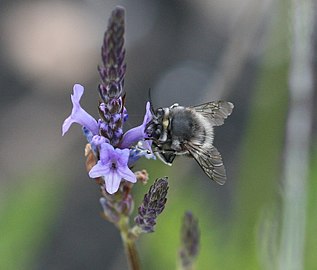Lavandula canariensis
Appearance
| Lavandula canariensis | |
|---|---|

| |
| In habitat, Playa Blanca, Lanzarote | |
| Scientific classification | |
| Kingdom: | Plantae |
| Clade: | Tracheophytes |
| Clade: | Angiosperms |
| Clade: | Eudicots |
| Clade: | Asterids |
| Order: | Lamiales |
| Family: | Lamiaceae |
| Genus: | Lavandula |
| Species: | L. canariensis
|
| Binomial name | |
| Lavandula canariensis | |
Lavandula canariensis (common name, Canary Island lavender) is a species of flowering plant in the family Lamiaceae, native to the Canary Islands.[3] It was first described by Philip Miller in 1768.[1][2]
Description
[edit]Lavandula canariensis is a half-hardy, woody, evergreen shrub. The leaves are bipinnate, rich green,[4] and covered in fine, downy hairs. Flowers appear in spikes of small, fragrant blue, opening from dark purple buds, and are borne on branching stems in summer.[5]
-
Flowers with pollinator (Anthophora alluaudi)
References
[edit]- ^ a b "Plant Name Details for Lavandula canariensis Mill.", The International Plant Names Index, retrieved 2018-02-02
- ^ a b "Lavandula canariensis Mill.", Tropicos, Missouri Botanical Garden, retrieved 2018-02-02
- ^ a b "Lavandula canariensis", World Checklist of Selected Plant Families, Royal Botanic Gardens, Kew, retrieved 2018-02-02
- ^ "Lavandula canariensis | Canary Island Lavender | Lavender | plant lust". plantlust.com. Retrieved 2024-06-21.
- ^ "Lavandula canariensis | Shrubs/RHS Gardening". www.rhs.org.uk. Retrieved 2024-06-21.

